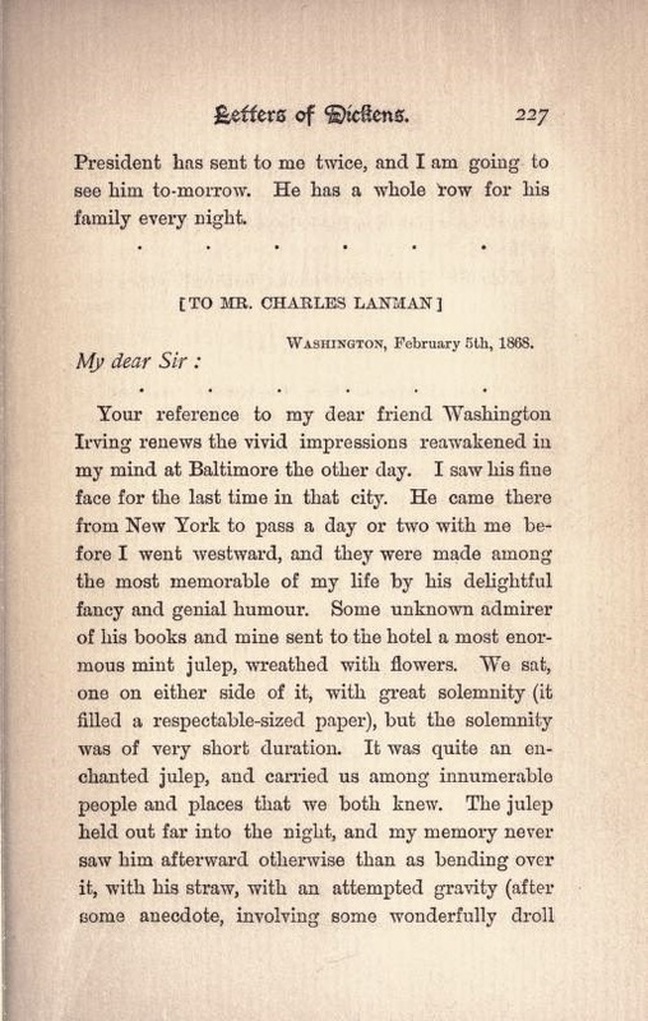

Dickens's Reflections on Visiting Baltimore in 1842
(The Washington Monument of 1815, which he refers to, is shown in this 20th-century photo of Mount Vernon Place.)
We stopped to dine at Baltimore and, being now in Maryland, were waited on, for the first time, by slaves. The sensation of exacting any service from human creatures who are bought and sold, and being, for the time, a party as it were to their condition, is not an enviable one. The institution exists, perhaps, in its least repulsive and most mitigated form in such a town as this; but it IS slavery; and though I was, with respect to it, an innocent man, its presence filled me with a sense of shame and self-reproach. …
The most comfortable of all the hotels of which I had any experience in the United States, and they were not a few, is Barnum's, in that city (Baltimore): where the English traveler will find curtains to his bed, for the first and probably the last time in America (this is a disinterested remark, for I never use them); and where he will be likely to have enough water for washing himself, which is not at all a common case.
This capital of the state of Maryland is a bustling, busy town with a great deal of traffic of various kinds, and in particular, of water commerce. That portion of the town which it most favors is none of the cleanest, it is true, but the upper part is of a very different character and has many agreeable streets and public buildings. The Washington Monument, which is a handsome pillar with a statue on its summit; the Medical College; and the Battle Monument, in memory of an engagement with the British at North Point, are the most conspicuous among them. ~~ from American Notes, 1842
(I also once read that during his time in Baltimore, Dickens visited the Maryland State Prison and was favorably impressed by the warden’s program for what we would now call “vocational rehabilitation” –- teaching the inmates a trade they could use to earn money legitimately once they were freed. I have not been able to locate the source for this. ~~ Menalcus Lankford.)

Dickens returned to Baltimore on his second trip to America, 1867-1868, and did his famous readings at an apparently gorgeous venue, long gone, Concordia Hall (above) on Eutaw Street. Here is Dickens's description of his reading to the people of Baltimore:
"They are very handsome women, with an Eastern touch in them, and dress brilliantly. I have rarely seen so many fine faces in an audience. They are a bright responsive people likewise, and very pleasant to read to. My hall is a charming little opera house built by a society of Germans: quite a delightful place for the purpose. I stand on the stage, with the drop curtain down and my screen before it. The whole scene is very pretty and complete, and the audience have a 'ring' in them that sounds deeper than the ear." ~~ The Life of Charles Dickens. John Forster
Enjoy this amusing account from his letters of a wonderful afternoon in his Baltimore hotel room spent over a giant mint julep someone had sent up as a gift, he and his friend Washington Irving taking turns at the straws and growing increasingly sympatico!


from A Collection of Letters of Dickens, 1833-1870. New York: Charles Scribner & Son, 1889. Accessed on OpenLibrary.org, through the U. of Toronto.

The mint julep is a centuries-old mixed alcoholic drink, or cocktail, consisting primarily of bourbon (or some other spirit) and fresh mint. As a bourbon-based cocktail, it is associated with the American South and the cuisine of the Southern United States in general. ~~ Wikipedia